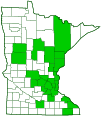Eastern American Jack-o’-Lantern Mushroom
(Omphalotus illudens)
Conservation • Description • Habitat • Ecology • Distribution • Taxonomy
|
|
||||||||||||||
Description |
Eastern American Jack-o’-Lantern Mushroom is a poisonous, bioluminescent, gill mushroom. It occurs in North America east of the Great Plains. It is found in woodlands growing on the trunk or stump of a hardwood, especially oak, or on the ground gaining nutrients from tree roots. It is usually small and found in large clusters. Occasionally, it is larger and solitary. The stalk is The cap is The flesh is yellowish, more or less the color of the cap but paler. It is inedible. The gills are closely spaced and bright yellowish-orange to orange. They are narrow and sharp, like the edge of a knife, and are not forked. They are usually luminescent when fresh, though this may be difficult to see. They are completely attached (adnate) or extend down along the stalk (decurrent). The spore print is white to yellowish. |
Similar Species |
Chanterelle (Cantharellus cibarius) has a long growing season and can be found in the spring. It is usually solitary. When in groups the stalks are separate, not joined at the base. The stalk is shorter. The gills are forked near the end (toward the margin of the cap) into two branches. They are shallow and the edges are thick, appearing as if “melted”. It is edible. |
Habitat and Hosts |
The trunks, stumps, and roots of hardwoods, especially oaks |
Ecology |
Season |
Late summer to fall |
Bioluminescence |
Eastern American Jack-o’-Lantern Mushroom is said to be bioluminescent, to glow in the dark. The gills emit a green glow due to the enzyme luciferase acting upon the compound luciferin. One report had it bright enough to read a newspaper by. More trusted sources suggest that the green glow is very faint and may not always be visible to human eyes. To see the light it is suggested that a person take a fresh, actively growing specimen into a closet, close the door, and wait 30 minutes for their eyes to become accustomed to the dark. Only then will a dim green glow be visible… or not. |
Distribution |
||
|
Sources |
|
| 8/5/2024 | ||
Occurrence |
||
Common |
||
Taxonomy |
|
Kingdom |
Fungi (Fungi) |
Subkingdom |
Dikarya |
Phylum |
Basidiomycota (Basidiomycete Fungi) |
Subphylum |
Agaricomycotina (Higher Basidiomycetes) |
Class |
Agaricomycetes (Mushrooms, Bracket Fungi, Puffballs, and Allies) |
Order |
|
Suborder |
Marasmiineae |
Family |
Omphalotaceae |
Genus |
Omphalotus (Jack-o’-lantern mushrooms) |
Eastern American Jack-o’-Lantern Mushroom was originally described in 1822 and named Agaricus illudens. In 1887 it was reclassified as Clitocybe illudens. In 1979 it was moved again and acquired its current name, Omphalotus illudens. Some authors today consider it the same as the European species and give it that name, Omphalotus olearius. However, that is not widely accepted nor is it supported by recent research. |
|
Subordinate Taxa |
|
|
|
Synonyms |
|
Agaricus olearius Agaricus olearius ssp. olearius Clitocybe illudens Clitocybe olearia Omphalotus olearius Pleurotus olearius |
|
Common Names |
|
Eastern American Jack-o’-Lantern Mushroom Eastern Jack-o’-Lantern Mushroom Jack-o’-Lantern Mushroom |
|
Eastern American Jack-o’-Lantern Mushroom gets its common name from its bright orange color, its appearance around Halloween, and its eerie green glow in the dark. |
|
Glossary
Universal veil
An egg-like structure that envelopes all or most of a developing gill mushroom. Remnants of the universal veil sometimes visible on a mature mushroom are patchy warts on the cap, a ring on the stalk, and a volva at the base of the stalk.
Volva
Also called cup. A cup-like covering at the base of a mushroom stem, sometimes buried. It is the remnants of the universal veil ruptured by the mushroom pushing through. It is found on Amanita, Volvariella, and some other mushrooms.
Visitor Photos |
||
Share your photo of this fungus. |
||
This button not working for you? |
||
Greg Watson |
||
Eastern American Jack-O'-Lantern (Omphalotus illudens) You do have pictures of this one, but I thought I would share it because as I understand things, this was an impressive amount of them in one place. |
||
Gerry Garcia |
||
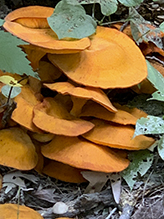 |
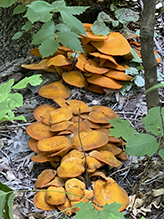 |
|
Jack O' Lantern mushrooms along the Hidden Falls Trail in Nerstrand Big Woods State Park in Rice County, MN |
||
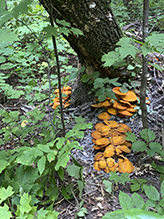 |
||
Jill Jacobson |
||
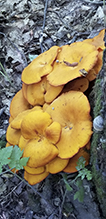 |
||
Found them off of Vergas Trail. |
||
Kendra Sommerfeld |
||
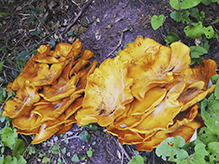 |
||
Magic Mountain Mushroom Hunters |
||
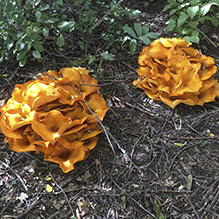 |
||
Cory Schultz |
||
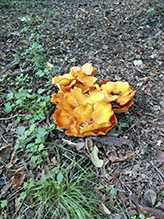 |
||
MinnesotaSeasons.com Photos |
||

Slideshows |
|

Visitor Videos |
||
Share your video of this fungus. |
||
This button not working for you? |
||
|
Other Videos |
||
Jack O'Lantern Mushroom (Omphalotus illudens) |
About
Published on Jun 16, 2015 Jack O'Lantern Mushroom (Omphalotus illudens). Fantastic bright orange poisonous toadstool found growing in large clumps on dead trees, roots, or stumps. As the mushroom ages the center becomes sunken, forming a bowl or cup. The mushroom gets its name because of its color (like a pumpkin) and the fact that its gills are reputed to glow in the dark (I'll have to go back and check at night!). Shot 6/15/15 in Transylvania County, NC Music: Unde Altus by Dano at DanoSongs.com |
Orange Jack-O-Lantern Mushrooms And Puffball Mushrooms |
About
Published on Aug 25, 2015 http://youtu.be/A-Qr-NyoYI0 Orange Jack-O-Lantern Mushrooms And Puffball Mushrooms The Ompha-lotus illudens commonly known as Jack-o-lantern mushrooms, which is a large orange mushroom found in clumps on decaying wood or buried roots or at the base of hardwood trees in Eastern North America. It’s gills often exhibit a weak blue green color bioluminescene and in low light the gills will glow underneath the mushroom head. The glowing is due to an enzyme Luci ferase and a compound called luciferin leading the emission of light much like a firefly. Yet, do not let the beautiful orange and the emission of glowing light seduce you with its beauty. Jack-o-lantern mushrooms are extremely poisonous and toxic to humans. The poisonous chemical compounds are illudin. Jack-o-lantern mushrooms eaten raw or cooked will cause severe simultaneous vomiting, cramps and diarrhea, which can last 2 days. The Puffball mushroom is a member of several groups of fungi. The distinguishing feature of all puffball mushrooms is that they do not have an open mushroom cap with spore-bearing gills. Instead, spores are produced internally, in a spheroidal fruitbody pod. As the spores mature, they form a mass called a gleba in the center of the fruit body, Eventually the puffball develops an aperture an opening or dries and becomes brittle, and splits, and the spores escape. The Puffball fungi mushrooms are called puffballs because clouds of brown dust-like spores are emitted when the mature fruitbody bursts, or in response to impacts such as those of falling raindrops or when stepped by an animal or human. , Jack-O-Lantern Orange Mushrooms, Wild Orange Mushrooms, Mushrooms and Fungi, Hans Moore, Omphalotus olearius, Poisonous mushrooms, Jack-O-Lantern mushrooms, Puffball mushrooms, Giant Puffball Mushroom, Calvatia cynathiformis, Hard Shell Puffball Mushrooms, Are mushrooms poisonous, Can you eat mushrooms found in your yard, how to tell if mushrooms are poisonous, Is it safe to eat raw mushrooms? |
Chanterelle Look Alikes - Toxic Jack O' Lantern Mushroom Identification |
About
Published on Aug 17, 2013 Chanterelle look alikes. Toxic jack o' lantern mushroom identification. The jack o' lantern mushroom, Omphalotus olearius or Omphalotus illudens, may be confused with edible chanterelle mushrooms, but the color of the flesh and gills are a dead giveaway that the two fungi are completely different. Jack o' lanterns are saprobic meaning they grow from wood, whereas chanterelles are not saprobes. But, as you can see in this video the jack o' lanterns appear to be growing from the ground not wood. I find many jack o' lantern mushrooms growing in open lawns and I find chanterelles that appear to be growing from wood. These habitat and growth characteristics are listed in most field guides and mushroom identification books, but, they are not nearly as reliable as paying close attention to the gills and color of the flesh, i.e. the physical features of the fungi in question. Paying close attention to physical features of mushrooms is critically important in order to get a positive identification. As long as one pays close attention to the physical characteristics of fungi, most of the common and abundant gourmet edible fungi can be easily and safely identified for the table. Jack O' Lantern mushrooms have been reported to glow in the dark, a bioluminescent fungi. To see mushroom, plant, garden and outdoor photos, field guides I use, plant and mushroom identification books, and other interesting stuff visit me on Facebook www.facebook.com/michigan.wilderness Thanks for watching, commenting, subscribing to, and supporting this channel. If you like this video please give a thumbs up and share it with othe |
Omphalotus illudens : Champimaginatis. English Text |
About
Uploaded on Oct 18, 2009 Omphalotus olearius. Omphaloyus olearia, Clitocybe ou Pleurote de l'olivier. Vénéneux ! English Text |
MICOLOGIA - Omphalotus olearius |
About
Published on Jan 22, 2014 Altro strepitoso video del Micologo Nicola Amalfi su una specie fungina che ogni anno è causa di avvelenamenti. Con la spiegazione fornita dal Dott. Amalfi tutto questo può essere evitato. BUONA VISIONE!!! Stefano&Antonello in collaborazione con il Dott. Nicola Amalfi. |

Visitor Sightings |
||
Report a sighting of this fungus. |
||
This button not working for you? |
||
| Gerry Garcia 9/1/2019 |
Location: Nerstrand Big Woods State Park Jack O' Lantern mushrooms along the Hidden Falls Trail in Nerstrand Big Woods State Park in Rice County, MN |
 |
| Jill Jacobson 8/24/2019 |
Location: Detroit Lakes, MN Found them off of Vergas Trail. |
| Kendra Sommerfeld 10/10/2016 |
Location: Mendota Heights, MN |
 |
| Magic Mountain Mushroom Hunters 8/20/2016 |
Location: Hackensack, MN |
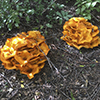 |
MinnesotaSeasons.com Sightings |
||

Created: Last Updated: © MinnesotaSeasons.com. All rights reserved. |
